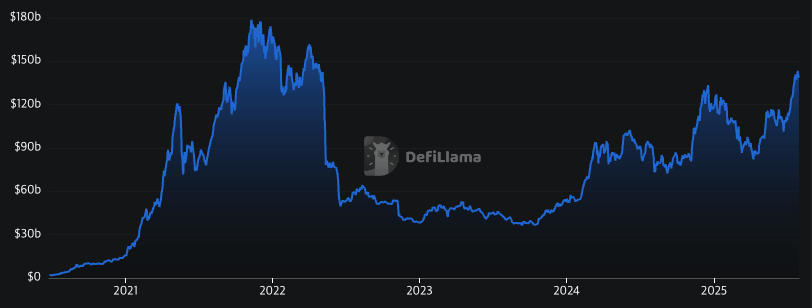DeFi Summer Returns? IMF Embraces Crypto and More
DeFi's TVL returns to pre-Terra levels, the IMF acknowledges cryptocurrencies in national wealth accounts, and Visa broadens stablecoin support as institutional adoption grows.
Welcome to the Asia Pacific Morning Brief—your essential digest of overnight crypto developments shaping regional markets and global sentiment. Grab a green tea and watch this space.
DeFi TVL hits pre-Terra levels while IMF formally recognizes crypto in national accounts. Visa expands stablecoin support across multiple blockchains as institutional adoption accelerates amid growing regulatory clarity worldwide.
DeFi Summer Back? TVL Hits Pre-Terra Levels
DeFi total value locked reached $138 billion, matching pre-Terra collapse highs. The sector briefly exceeded $140 billion during the July 28-30 trading sessions. This marks the highest TVL since May 2022’s UST-LUNA crisis.
 DeFi total value locked reached $138 billion, matching pre-Terra collapse highs. Source:
DefiLlama
DeFi total value locked reached $138 billion, matching pre-Terra collapse highs. Source:
DefiLlama
Lending and staking services drove the recovery across major protocols. AAVE leads with $34.405 billion in locked assets for lending operations. Lido follows closely at $33.619 billion in liquid staking services.
EigenLayer rounds out top three with $18.029 billion in restaking protocols. Whether this signals a sustained DeFi revival remains uncertain. Market observers question if momentum can surpass 2020’s original summer.
IMF Embraces Crypto in National Accounts
The International Monetary Fund softened its stance on digital assets this week. Global regulators updated national wealth measurement standards to include Bitcoin and cryptocurrencies. The revised System of National Accounts now classifies crypto as “non-produced nonfinancial assets.”
Countries will report crypto holdings on national balance sheets starting 2029-30. These assets remain excluded from GDP calculations but gain formal recognition. The change reflects growing adoption and potential financial stability implications.
El Salvador benefits significantly from this policy shift amid ongoing IMF negotiations. The country’s 6,000+ Bitcoin holdings will now appear in official wealth statistics. This development marks a pragmatic turn in institutional acceptance of digital assets.
The framework modernizes economic data collection for the digital age. New guidelines also cover artificial intelligence, cloud services, and digital platforms. Regulators aim to balance financial innovation with systemic stability concerns.
Visa Expands Stablecoin Support Across Multiple Blockchains
Visa added PayPal’s PYUSD, euro-backed EURC, and Global Dollar to its platform. The payment giant now supports Stellar and Avalanche blockchain networks. Users can send payments or convert stablecoins to fiat currency.
The expansion builds on existing USDC support across Ethereum and Solana. Visa has processed over $225 million in stablecoin volume since 2023. Institutional interest surged following the passage of the GENIUS stablecoin bill.
Mastercard reports 30% of transactions are already tokenized through crypto partnerships. JPMorgan and Bank of America are developing similar stablecoin infrastructure. Amazon and Walmart explore issuing proprietary stablecoins for cross-border payments.
The $256 billion stablecoin market attracts traditional finance and tech giants. Visa’s May investment in BVNK signals deeper crypto infrastructure commitment. Cross-border transactions remain expensive through legacy payment networks.
Disclaimer: The content of this article solely reflects the author's opinion and does not represent the platform in any capacity. This article is not intended to serve as a reference for making investment decisions.
You may also like
After bitcoin returns to $90,000, is Christmas or a Christmas crash coming next?
This Thanksgiving, we are grateful for bitcoin returning to $90,000.

Bitcoin security reaches a historic high, but miner revenue drops to a historic low. Where will mining companies find new sources of income?
The current paradox of the Bitcoin network is particularly striking: while the protocol layer has never been more secure due to high hash power, the underlying mining industry is facing pressure from capital liquidation and consolidation.

What are the privacy messaging apps Session and SimpleX donated by Vitalik?
Why did Vitalik take action? From content encryption to metadata privacy.

The covert war escalates: Hyperliquid faces a "kamikaze" attack, but the real battle may have just begun
The attacker incurred a loss of 3 million in a "suicidal" attack, but may have achieved breakeven through external hedging. This appears more like a low-cost "stress test" targeting the protocol's defensive capabilities.

